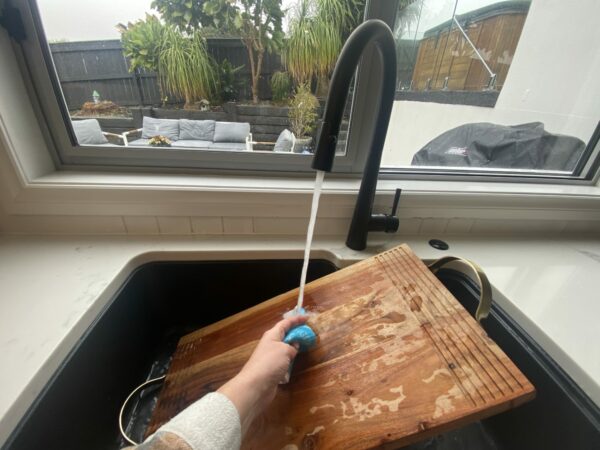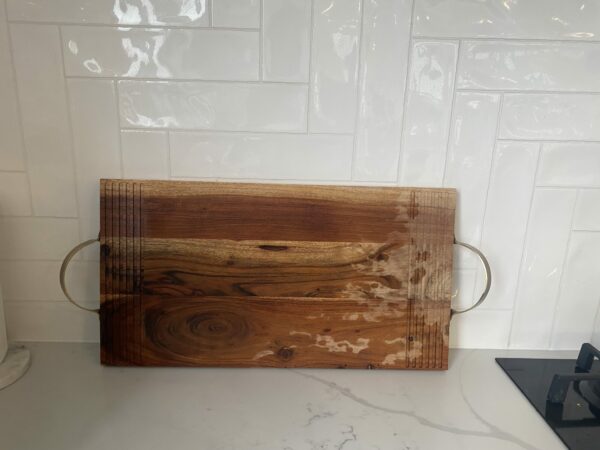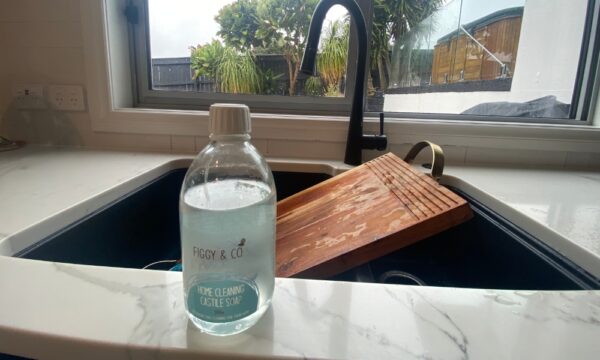How to Clean and Maintain Wooden Chopping Boards

Without doubt, every kitchen needs a least one good chopping board – and a wooden board is the ideal choice for a natural, non-tox kitchen.
Wooden boards can get a bad rap – some say they are difficult to clean and look after. Because of this, plastic cutting boards have been sold to us an easy care, more hygienic alternative. However, studies now tell us this is not the case. While the popularity of wooden boards may have waivered for a time under the rule of plastic fantastic, they are now more popular than ever as households take a more eco-friendly approach to living – and a plastic board can never look as good on your bench!
This how-to guide shares all our best tips for cleaning your board and the do’s and don’ts to keep it looking tip-top and well maintained – after all, a good wooden cutting board is an investment that’s worth looking after.
Here’s everything you need to know about naturally cleaning and maintaining your wooden chopping boards.
How to Clean A wooden chopping board
The key to keeping your wooden board in top shape is to make sure it thoroughly dries out after you have cleaned it and doesn’t stay wet. Leaving your board wet or soaking it is the quickest way to damage it permanently.
1. After cutting bread or making a snack
Use a clean, damp kitchen cloth and simply wipe off any crumbs or loose food and store as normal – there is no need to wet wash your board if there hasn’t been any food transferred to the board that won’t brush loose easily.
2. After preparing a meal
Soap and warm water are your best friends for looking after your wooden board. Wash off your board in the sink while the tap is running by adding a small amount of Castile soap and sudsing up the surface by scrubbing with a brush or using a cloth. Or wash your board in the sink when you are washing the dishes by hand. Dry your board immediately or let it drip dry.
3. Cleaning up oily residue
Be it a pesto blob on your board or you’ve been cutting up sundried tomatoes – these, of course, will leave a concentrated oily residue that stands out. The key here is to scrape or wipe off the worst of the oil. Then apply 1-2 teaspoons of Castile soap directly onto the oil and scrub it around until the oil turns white. This shows the soap has surrounded the oil and is now ready to rinse off with hot water. Oily resides like this always stand out more on non-oiled boards.
4. Cleaning after raw meat
After cutting raw meat – especially chicken, your board needs ‘a good hot, soapy scrub’! While you are doing this be mindful not to splash water around your kitchen, as this will potentially have chicken-born bacteria in it, and you don’t want to spread this around – no one wants food poisoning, right? First, get your tap running hot, then pop your board in you sink with it angled so the water will run off down the board and into the drain. With a brush, brush downwards to loosen off any meaty bits and rinse off blood. Now put the rinsed board in the bottom of the sink, add 1-2 teaspoons of Castile soap and give it a good scrub – all the way to the corners. Rinse the board with hot water, again direct the flow into the drain. Now give the board a second soapy wash – this time also scrub the bottom of the board and the sink at the same time – now all the surfaces that may have been splashed with meaty juices are also clean (this double wash method of cleaning is very useful for not getting food poisoning from raw chicken!).
What about bacteria on your board?
A study from the University of Wisconsin looked at how bacteria behaved on the surface of plastic chopping boards vs. wooden ones. What they found made sense – wooden surfaces are safe for all food preparation. While the plastic was expected to be more hygienic, it wasn’t. Here’s what they found: wooden boards have a special trick because wood has of lots of tiny tubes! The study found that a wooden board can suck bacteria into these tubes and below its surface and kill the bacteria. What!?! How cool is mother nature! Whereas on a plastic board, the bacteria remained on the surface and then grew in numbers.
All the wood was good! The study tested brand new and used wooden boards. They included boards that were oiled and not oiled – all preformed very similarly and all were better than plastic. In fact, in one part of the experiment – they coated the experimental boards in a bacterial broth and left them overnight – the wooden boards were found to have LESS bacteria on them the next day, while the plastic boards had considerably more.
It’s safe to say, that when paired with a good washing routine (hot soapy water), a wooden board is a safe and trustworthy kitchen sidekick!
Why Choose Castile Soap for Cleaning
Castile soap gets things slippery, and the grease and muck slide off. It works in the same way as detergent but is the gentle and a safer alternative to detergent, especially for our skin and waterways. Castile soap can be used diluted as in a sink of water or can be used undiluted directly on your board for more targeted cleaning after prepping meat or something oily, for example. Figgy Castile soap is 100% pure soap with no nasties, additives, dyes or perfumes. This makes it perfect for getting your board nice and clean without leaving behind residues you’d rather avoid.
Removing strong smells from your wooden board
If your board has absorbed some strong odours like garlic or onions that don’t lift with a soapy wash, here are a couple of deodorising deep cleans to neutralise the odours.
1. Baking soda scrub
Sprinkle baking soda over the surface and scrub with a half lemon. This non-toxic combo fizzes as it cleans and naturally deodorises, getting rid of any nasty odours
2. Lemon and salt
Alternatively, another effective method is the classic lemon and salt. Sprinkle salt on the board, then scrub with the cut side of a lemon. The salt acts as a mild abrasive to remove stains, and the lemon leaves your board smelling fresh. For strong smells, leave the scrub on your board for an hour or so before rinsing off.
What to do if your wooden board grows mould
If the mould is growing on a bit of food that has not been washed off properly – then the board can be washed as mentioned above for preparing meat and it will be fine.
If the mould is growing from your wooden board, it is a bad sign. Typically, this will happen when a chopping board is stored while still wet. Mould takes hold when mould spores floating in the air land and grow.
Mould is a tricky fix because it grows in two parts. Firstly, there is what’s superficial and seen, this is the black spots or grey fluffy stuff. Secondly, there is what’s not seen, the mycelium beneath the surface – think of it like the root of a tree. If your board is in this state – you can try soaking it in diluted chlorine bleach. However, the bleach will damage the wood and so it is probably better to get rid of it and get a new one.
Remember always let your board dry out thoroughly after washing it.

Taking care of your wooden board
A wooden board does not need to be oiled or waxed, but it does help maintain the surface of the board and keep it looking great. Oiling helps the surface from becoming dry and the wood cracking prematurely. There is no hard rule about how often you need to oil or wax, as it comes down to how often you wash your board as it’s the cleaning the removes the surface coating a little each time. When you do choose to recoat your board – ensure it is clean and very dry.
1. Oiling your board
Apply a food safe oil to your board like this one made from tung oil from the natural paint company. Follow the application instructions that come with the oil but typically you apply it with a cloth or roller, let it sit until it absorbs, then use a clean cloth to buff the board and remove any excess oil.
2. Waxing your board
Apply the wax and rub it in at the same time. Use a clean cloth to wipe away any excess as you go.
3. Avoid the dishwasher
Never, and we mean never, put your wooden chopping boards in the dishwasher. The high heat and prolonged water exposure can cause warping, cracking, or splitting. Stick to hand washing and your board will stay in top shape.
4. Repairs
If your board is looking rough from being chopped into and you would like to tidy that up – use sanding paper to sand out the knife marks. Start with a course paper and then move to a finer grit to keep the wood fibres smooth. After sanding is a great time to apply a coat of oil or wax.
Benefits of choosing a wooden board
Wood Vs Bamboo chopping board
Bamboo boards are harder than wood, which can make them quicker to dull a knife. The nature of bamboo means a chopping board has lots of small pieces glued together – this construction may mean you are exposing yourself to unsafe glues. Bamboo is also more porous – which means it is more likely to trap moisture and grow mould.
Wooden vs Plastic chopping board
Wooden chopping boards offer several advantages that make them a superior choice in the kitchen. As explained above, wooden boards are more hygienic than plastic, and while a plastic board can go in the dishwasher – our cleaning guide has shown just how easy it is to wash a wooden board by hand.
The other major concern is plastic contamination. When the knife strikes the surface of the board, small pieces of plastic break off – these are microplastics. Studies have shown that plastic chopping boards can shed significant amounts of microplastics into food during use. Other studies have shocking findings, that microplastics have been found in human bloodstreams, lungs, and even placentas. While the research is ongoing, it is now established that microplastics are harmful to people and the planet.
So, weather you already own a wooden board or if you are getting a new one for your home, remember these natural cleaning methods for how to clean a wooden chopping board and maintenance tips to keep it hygienic, and gorgeous for years to come. Give your board the love it deserves, and it will reward you with the best, safe and stylish food prep. Happy cleaning and happy chopping! 🌿✨
Get natural cleaning tips from our blog!
We want you to have everything you need so you can clean your home healthier – and look out for the planet too. Take a browse though our blog and learn more about natural cleaning, safe ingredients and so much more!
Get natural cleaning tips from our blog!
We want you to have everything you need to clean your home healthier while avoiding unwanted chemicals – and looking out for the planet too! Take a browse through our blog and learn more about natural cleaning, safe ingredients and so much more!
